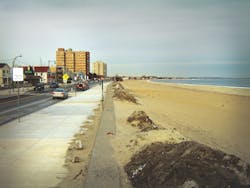Revitalizing Revere Beach
About the author: Steve Hides is president of Hydro Americas. Hides can be reached at [email protected].
Revere Beach, “America’s First Public Beach,” opened to the public on July 12, 1896, with a first-day attendance of about 45,000 people. For the first half of the 20th century, the 3-mile beach was well known for its amusement rides, roller rinks and dance halls.
The beach fell on hard times during the 1960s and 1970s. When the Blizzard of 1978 hit, it delivered the final blow to the struggling community, destroying much of the sea wall, promenade, entertainment attractions and businesses. In the mid-1980s, after years of disrepair, the community developed a vision for restoration and revitalization. First, the amusements were replaced with high-rise condos. By 1992, the state and federal government funded the restoration of the beach pavilions, the re-sanding of the beach and the revitalization of the southern half of Revere Beach Boulevard.
Unfortunately, the northern section of the beach—along Revere Beach Boulevard—remained as it had been in the previous decades. It was notoriously difficult to navigate and the scenic promenade from the boom years had been converted to angled roadside parking during leaner times, making the roadway narrow. The absence of sidewalks created additional hazards for pedestrians attempting to cross the boulevard to the beach.
The existing storm drainage system also was not working well. The system was designed to collect storm water runoff from the boulevard and parking areas and transport it through pipes under the beach and out into the ocean, where it would be discharged without any treatment. Sand blowing off the beach would clog the drains and pipe network with sand, restricting the flow capacity of the pipes and causing the curbside stretch of pavement to be perpetually occupied by unsanitary puddles, which beachgoers had to wade through in order to access the beach.
Designing a Solution
Because the beach is a “barrier beach,” occupying only a narrow sand bar between the ocean and marsh, the drainage and expansion options were limited. The amount of storm water that had to be managed was substantial, but something had to be done. So, in 2006, the Massachusetts Department of Conservation and Recreation (DCR) embarked on a major project to improve the condition of the northern section.
The project was a huge undertaking. Planners from DCR, the mayor of Revere, and other public officials worked closely with the engineering team led by Parsons Brinckerhoff of Boston to design and execute a strategy for redevelopment of the roadside parking and improvements to the drainage design. The project team’s drainage consultants at Nitsch Engineer Inc. designed a new drainage layout that would consist of 60 combined drainage inlets and storm water treatment units installed along the 1.5-mile stretch of road to remove sand, grit, trash, oil and debris from the storm water runoff before being discharged to a long, underground infiltration gallery that directs treated water into the sandy underlying soils. The upgraded storm water system eliminated the need for the unsightly pipes that previously discharged untreated road runoff into the ocean.
D’Alessandro Corp., the contractor on the project, working closely with the project engineers, selected Hydro Intl.’s First Defense vortex separators as the storm water treatment devices for the project. The units achieved the required level of storm water treatment in a smaller footprint and at a lower cost than the other storm interceptors that were considered.
The small footprint of the vortex separators and their lighter weight and slimmer profile worked well in the tight confines of the space, as the new units had to fit in the space of the old drainage inlet structures. The units made it easier and quicker for the contractor to install.
“The 60 First Defense units saved some money and time, and worked well with the downstream infiltration systems to solve our problem,” said project manager Rachel Burckardt, P.E., of Parsons Brinckerhoff. “I was very pleased. Installation went off without a hitch. The project was successful in every aspect, and it was even nominated for Parsons Brinckerhoff’s ‘Project of the Year.’”
“The First Defense was specifically designed for this type of application—an ultra-urban location where the drainage design splits one large redevelopment site into smaller sub-catchments where storm water is treated at the inlet to the storm drain,” said David Mongeau, regional sales manager who oversaw the project for Hydro Intl. “We were happy that we could supply an economical solution that will continue to treat storm water runoff from the boulevard long into the future.”
Successful Operation
Today, the units “are working well in that location,” said DCR’s Environmental Section Chief Rob Lowell. “The infiltration galleries receive inflow from the devices installed on the drainage system inlets to control sediment loading. We clean the units annually to maintain the system.”
The health of the beach no longer is jeopardized by untreated storm water runoff from the street and parking. Routine testing for the types of bacteria that can affect the health of beachgoers has confirmed that the general health of the beach has improved greatly.
State spending to improve Revere Beach and its vicinity is now well into its final phase, with a new multi-level parking garage at Wonderland Station, which connects to a $20-million grand plaza and park that includes a 140-ft-long pedestrian walkway to the recently improved section of Revere Beach Boulevard. The decades of public investment have set the scene for the next phase—private investment. The new design of Revere Beach already has led to new small businesses in the area and plans are underway to build a new $500-million mixed-use complex with luxury apartments, a hotel, office spaces and retail shops.
Download: Here
